Topographic indices from DEM¶
This is a short demo of the pysoilmap.features module - which allows deriving some simple topographic features.
Setup¶
[1]:
import ee
import matplotlib.pyplot as plt
import numpy as np
[2]:
import pysoilmap.ee as psee
from pysoilmap.features import Topography, diff_gauss
from pysoilmap.plotting import add_colorbar
We will download a DEM via the Google Earth Engine API. For this, you will have to authenticate with a google account here:
[3]:
psee.initialize()
The SRTM data is in WGS84 (degree). We want a coordinate system in meters to get meaningful units in derived quantities.
So let’s request the data in 3-degree Gauss-Kruger zone 3, and pick a Region around Tübingen:
[4]:
crs = 'epsg:31467'
xmid = 3_499_159
ymid = 5_371_552
xscale = yscale = 90
xdim = 100
ydim = 100
xmin = xmid - xdim / 2 * xscale
xmax = xmid + xdim / 2 * xscale
ymin = ymid - ydim / 2 * yscale
ymax = ymid + ydim / 2 * yscale
The transform defines how pixel coordinates are calculated from the matrix indices. We have to set a negative yscale and set the offset to ymax in order to have the (0, 0) pixel as the top left corner:
[5]:
# [xScale, xShearing, xTranslation, yShearing, yScale, yTranslation]
transform = [xscale, 0, xmin, 0, -yscale, ymax]
Now download DEM from SRTM 30m dataset:
[6]:
srtm = ee.Image("USGS/SRTMGL1_003")
dem = psee.download_image(
srtm,
'elevation',
crs=crs,
transform=transform,
xdim=xdim,
ydim=ydim,
)
In order to download bigger images (>= 50 MB) you would have to export them to your google drive first, and then manually download from there. The export can be started as follows:
[7]:
if False:
task = ee.batch.Export.image.toDrive(srtm, **{
'description': 'DEM',
'crs': crs,
'dimensions': [xdim, ydim],
'crsTransform': transform,
})
task.start()
task.status()
Define a function for plotting multiple variables at once:
[8]:
def plot_maps(*images, **kwargs):
extent = np.array([0, xmax - xmin, 0, ymax - ymin]) / 1000
rows = len(images)
cols = len(images[0])
fig, axes = plt.subplots(
rows, cols,
squeeze=False,
figsize=(cols * 3, rows * 3))
for i, row in enumerate(images):
for j, (title, image) in enumerate(row.items()):
ax = axes[i, j]
ax.set_title(title)
ax.imshow(image, extent=extent, **kwargs)
add_colorbar(ax, size=0.1, pad=0.07)
if i == rows - 1:
ax.set_xlabel('x [km]')
if j == 0:
ax.set_ylabel('y [km]')
plt.tight_layout()
[9]:
plot_maps({'Elevation': dem})
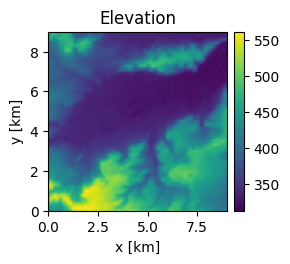
Features¶
By default Topography calculates spatial derivatives using central differencing:
[10]:
topo_0 = Topography(
dem,
cellsize=(xscale, yscale),
crs=crs,
transform=transform,
)
Alternatively, spatial derivatives can be calculated using a Gaussian derivative filter. This corresponds to smoothing the DEM with a Gaussian filter, and then calculating the derivative. It can be understood as calculating the derivative at a given lengthscale:
[11]:
topo_2 = Topography(
dem,
cellsize=(xscale, yscale),
crs=crs,
transform=transform,
diff=diff_gauss,
sigma=2,
)
[12]:
topo_5 = Topography(
dem,
cellsize=(xscale, yscale),
crs=crs,
transform=transform,
diff=diff_gauss,
sigma=5,
)
[13]:
topos = [topo_0, topo_2, topo_5]
Slope (tangent)¶
[14]:
plot_maps(*[{
"slope_x": topo.slope_x(),
"slope_y": topo.slope_y(),
"slope": topo.slope(),
} for topo in topos])
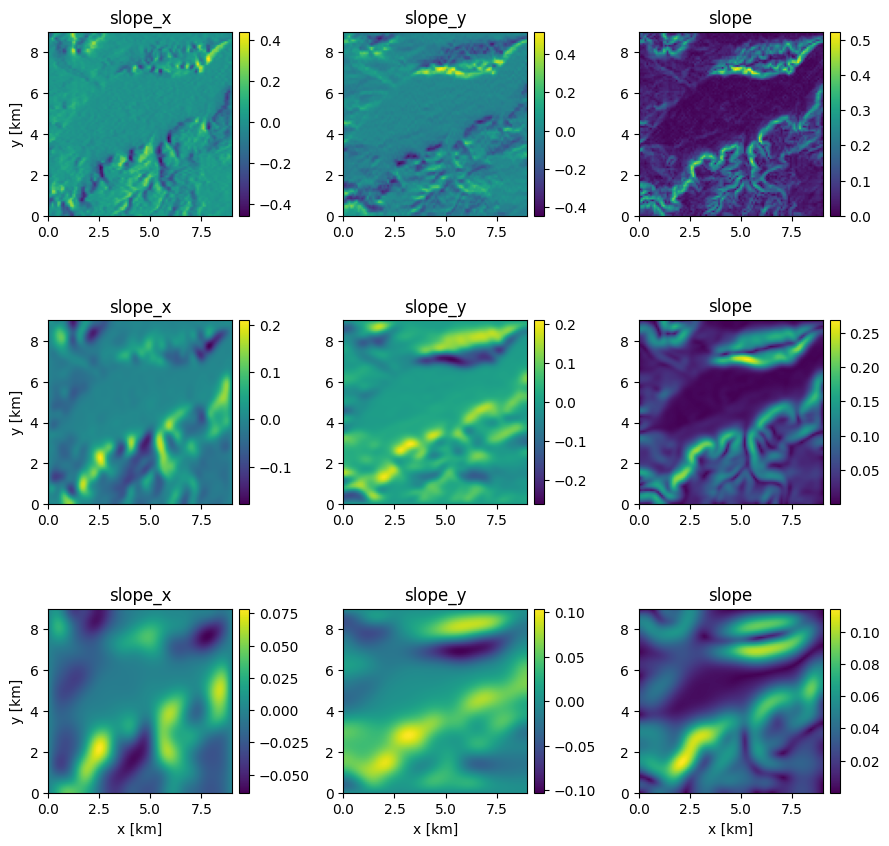
Slope (angle)¶
[15]:
plot_maps(*[{
"slope_angle_x": topo.slope_angle_x() * 180 / np.pi,
"slope_angle_y": topo.slope_angle_y() * 180 / np.pi,
"slope_angle": topo.slope_angle() * 180 / np.pi,
} for topo in topos])
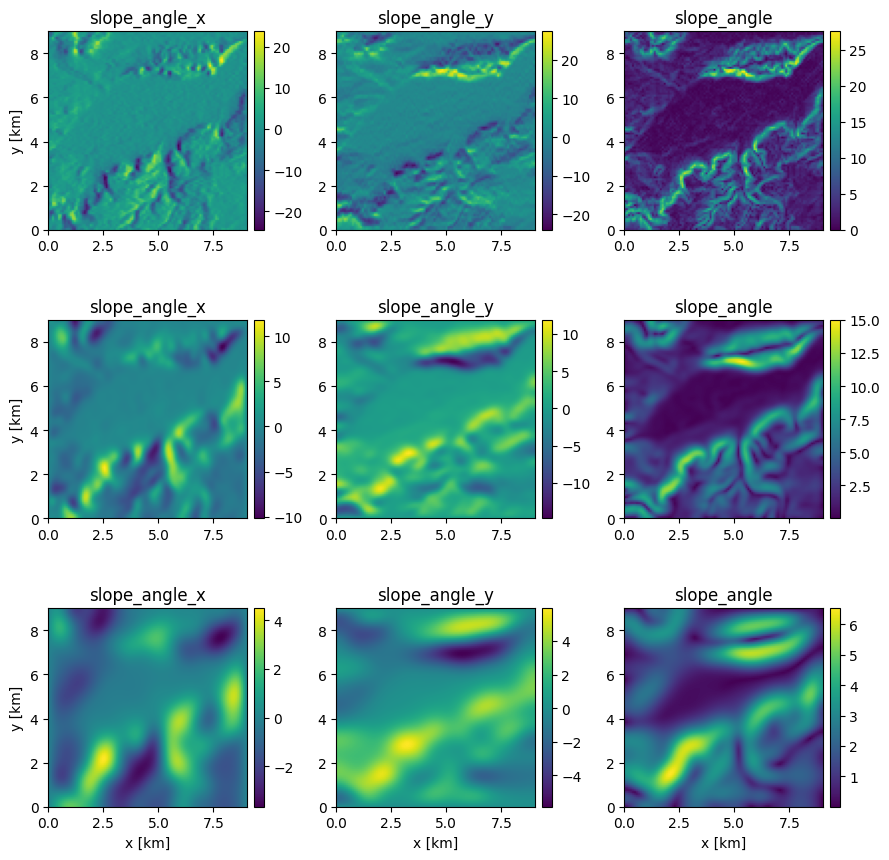
Slope (sine)¶
[16]:
plot_maps(*[{
"verticality_x": topo.verticality_x(),
"verticality_y": topo.verticality_y(),
"verticality": topo.verticality(),
} for topo in topos])
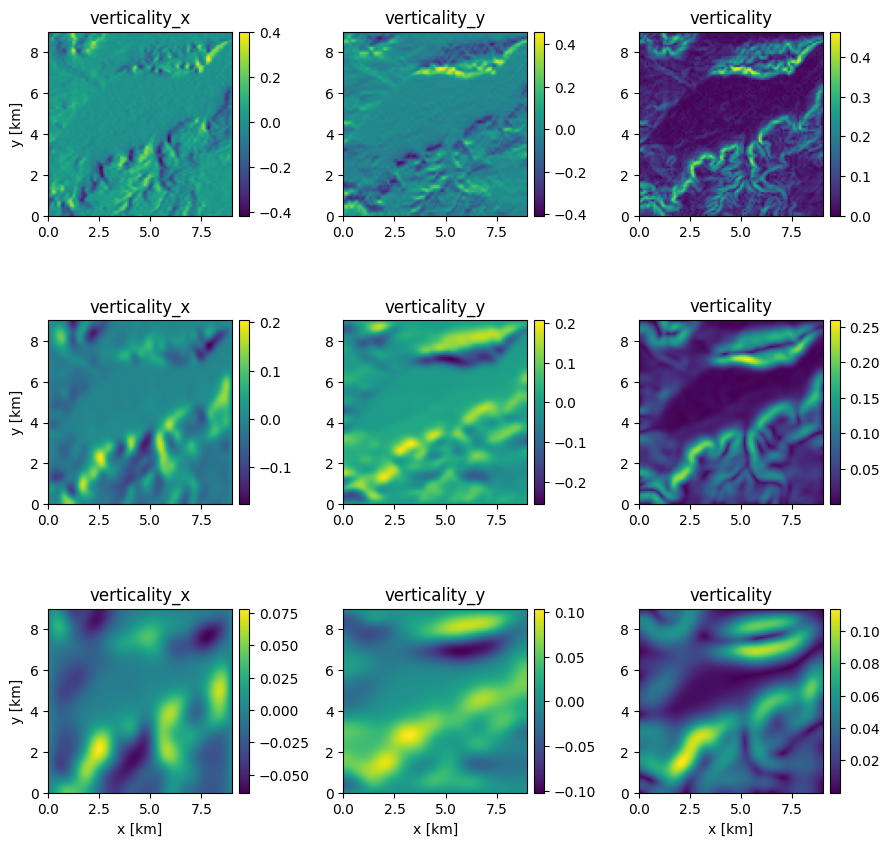
Curvature¶
[17]:
plot_maps(*[{
"curvature_x": topo.curvature_x(),
"curvature_y": topo.curvature_y(),
"curvature": topo.curvature(),
} for topo in topos])
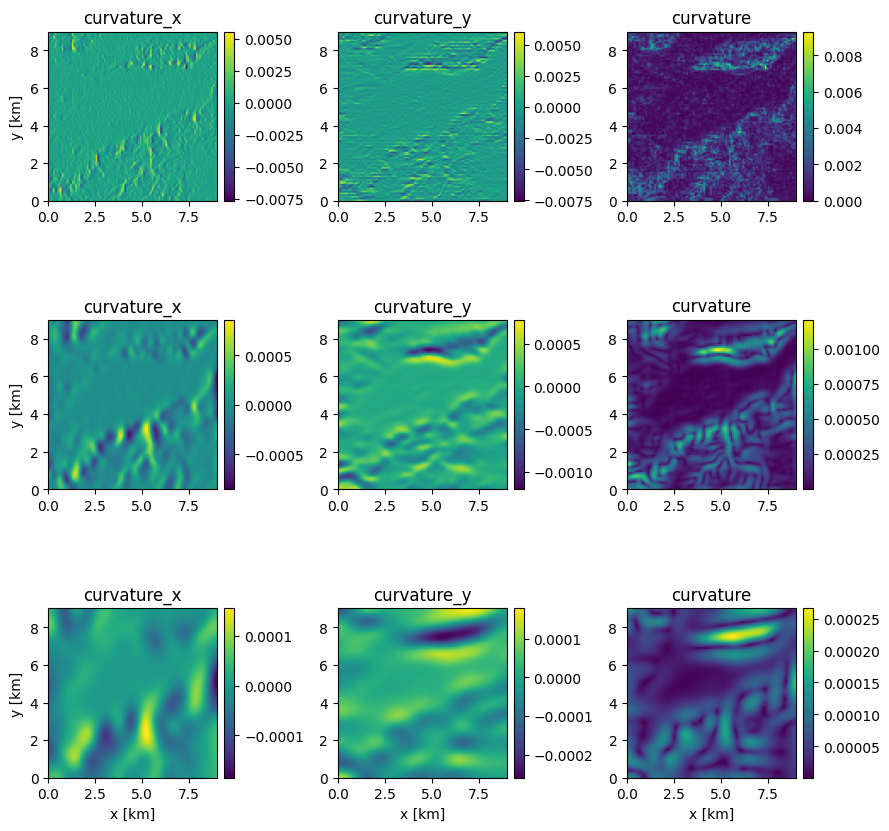
[18]:
plot_maps(*[{
"tang_curvature": topo.tang_curvature(),
"plan_curvature": topo.plan_curvature(),
"prof_curvature": topo.prof_curvature(),
} for topo in topos])
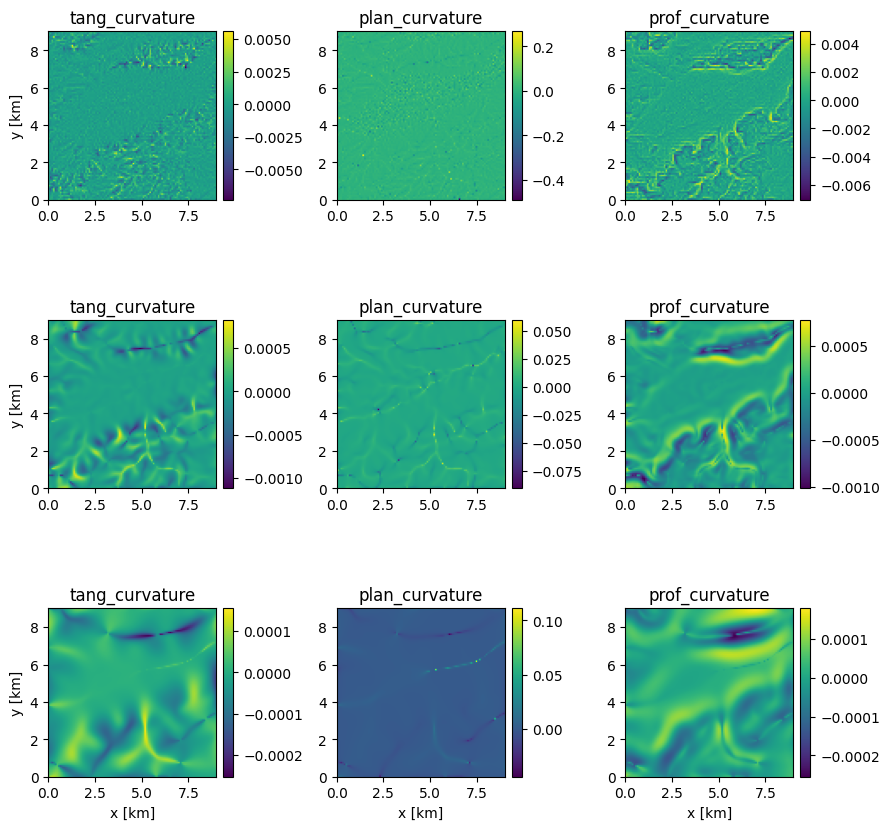
Aspect¶
[19]:
plot_maps(*[{
"aspect": topo.aspect(),
"eastness": topo.eastness(),
"northness": topo.northness(),
} for topo in topos])
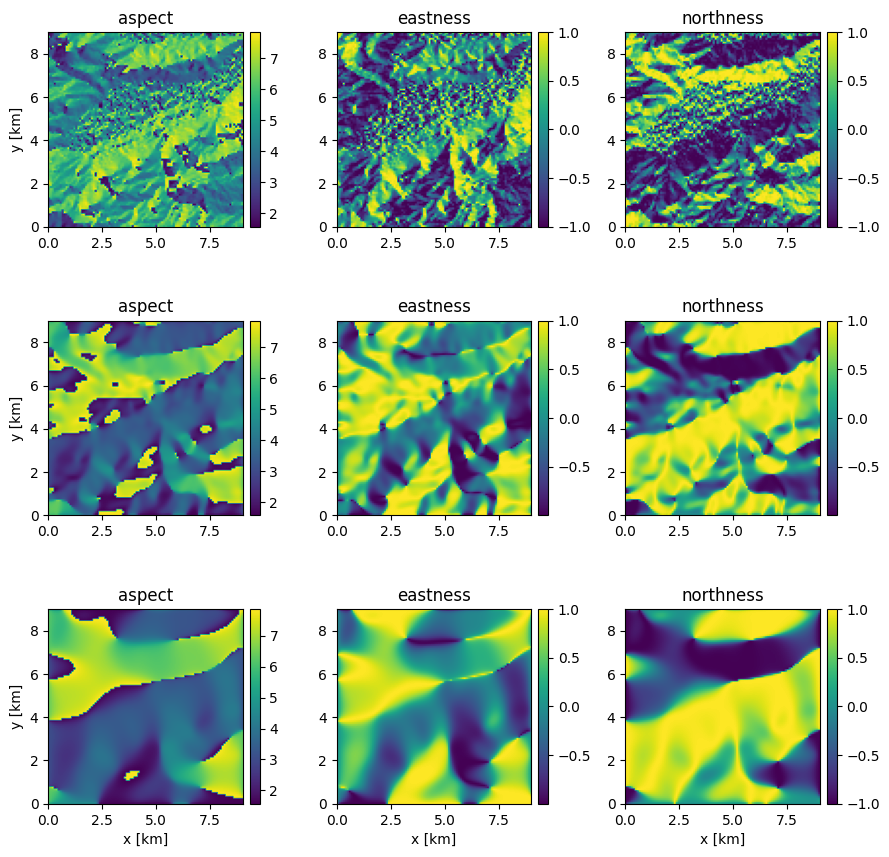
Irradiation¶
[20]:
plot_maps(*[{
"sun_exposure": topo.sun_exposure(),
"rad_angle": topo.rad_angle(),
} for topo in topos])
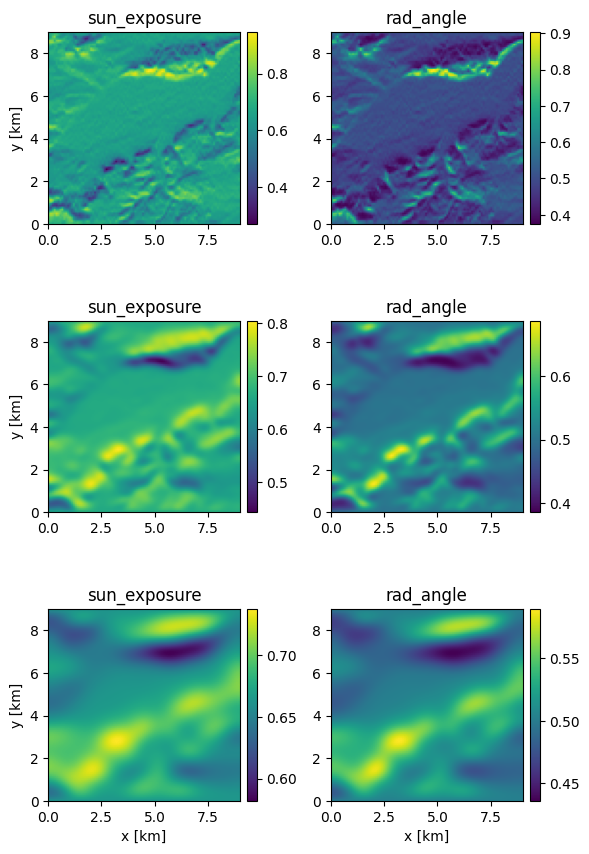
When downloading bigger images, it may be necessary to load them in chunks. This can be done as follows:
[21]:
dem23 = psee.download_image(
srtm,
'elevation',
crs=crs,
transform=transform,
xdim=xdim,
ydim=ydim,
xtile=2,
ytile=3,
threads=3,
)
assert (dem23 == dem).all()